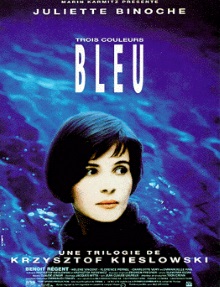
Krzysztof Kieślowski’s Three Colors trilogy is on the recommended list of a Coursera course that my wife is taking on the making of short films, so expect to see me write about all three of them in short order. This post covers the first of them which stars Juliette Binoche and is by most accounts the most accomplished of the three.
I’d previously heard about this trilogy and how each film is named after the three colors of the French national flag, blue, white and red in that order instead of the more familiar red, white and blue of the American flag. At that time, it struck me as being gimmicky. I thought that it was unlikely that the films could live up to such pretentious ambition. In fact I was wrong. Blue at least is the work of a masterful director who knows exactly what he is doing.
Binoche plays Julie, who loses both her husband and their only child in a car accident. Her tragedy is compounded by the fact that her husband is a celebrity composer who was on the verge of completing a heavily publicized work celebrating European unity, making the accident a matter of widespread public interest. She ends up by cutting all ties to her previous life, moving into a new apartment and trying to live anonymously.
But try as she does to move on, the past returns to haunt her. Snatches of familiar music permeate her moments, as she swims, as she sits in cafe. It is hinted that she had a larger role in her husband’s compositions than the public believes. Even as she forges connections with her new neighbors, she finds that she cannot ignore old ones and must eventually make peace with the past by completing her husband’s work.
As expected, the color blue dominates the cinematography, both in the lighting of entire scenes and in the objects that appear. Equally prominent is the use of music, the act of composing itself being intricately tied to her evolving feelings and relationships. The end result is an indulgence of the senses, a film that you lose yourself in instead of one that you spend time thinking about. One example of the exacting control that Kieślowski imposed over every scene is deciding precisely for how long a sugar cube must be drenched in coffee to look just right.
Binoche’s performance is inseparable from the character of the film itself and apparently Kieślowski swore that he would never have made it without her. She plays the grieving woman with such unflinching stoicism that it makes the people around her want to cry on her behalf. So the rare occasions when she does break down hits you like a punch in the gut. I especially like how the director refrains from unnecessary exposition. An object, a hanging lamp made of blue beads, appears prominently and is obviously of very special significance to her, yet exactly what it means to her doesn’t need to be explained. It’s a sign of the director’s trust in the actress’ ability to convey what is needed and the audience’s ability to grasp it.
No doubt students of filmmaking will be able to break down the composition of each scene to explain exactly why they are so effective. I just don’t know enough to articulate this as well as I would like. I only know that despite the lack of any large-scale scenic set pieces, this is an incredibly beautiful and elegant film that also delivers a powerful emotional charge without ever feeling like it’s resorting to clichés or falling into sentimentality.
One thought on “Trois couleurs: Bleu (1993)”